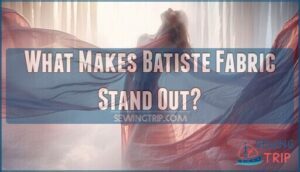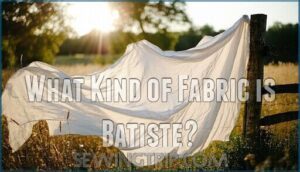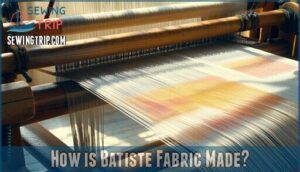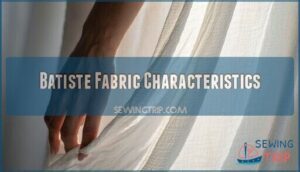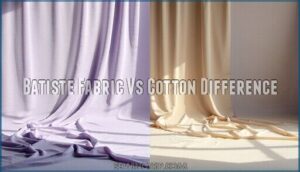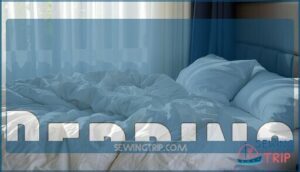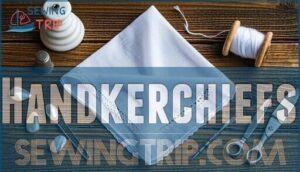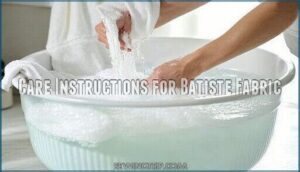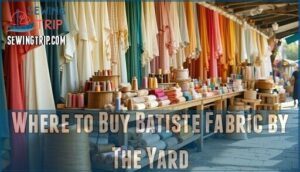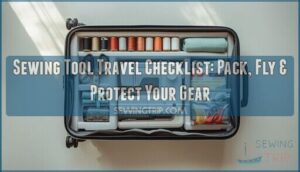This site is supported by our readers. We may earn a commission, at no cost to you, if you purchase through links.

You’ll recognize it by its paper-thin feel and subtle sheen that makes it perfect for delicate garments like blouses, lingerie, and baby clothes.
This fabric weighs just 2-4 ounces per square yard, making it lighter than a feather yet surprisingly durable.
Its tight weave creates a crisp texture that’s cooler than regular cotton, which is why it’s been a go-to choice for summer clothing and luxury bedding for centuries.
Unlike heavier cottons, batiste drapes beautifully and holds its shape well.
The secret behind its exceptional quality lies in the specialized manufacturing process.
Table Of Contents
- Key Takeaways
- The History of Batiste Fabric
- What Makes Batiste Fabric Stand Out?
- What Kind of Fabric is Batiste?
- How is Batiste Fabric Made?
- Batiste Fabric Characteristics
- What Does Batiste Fabric Look Like?
- Batiste Fabric Vs Cotton Difference
- Applications & Uses of Batiste Fabric
- Care Instructions for Batiste Fabric
- Where to Buy Batiste Fabric by The Yard
- Frequently Asked Questions (FAQs)
- Conclusion
Key Takeaways
- You’ll recognize batiste by its paper-thin feel and lightweight construction (2-4 ounces per square yard) that’s surprisingly durable despite being semi-sheer and breathable.
- You can use batiste for versatile applications including summer clothing, lingerie, bedding, and handkerchiefs since it drapes beautifully and feels smooth against your skin.
- You’ll find batiste differs from regular cotton through its specialized plain-weave construction using fine, combed fibers that create its signature soft texture and elegant appearance.
- You’ll need to care for batiste gently using cool water, mild detergent, air-drying, and low-heat ironing to maintain its delicate structure and prevent shrinkage.
The History of Batiste Fabric
How did a fabric named after a medieval French weaver become one of today’s most beloved textiles? The story begins in 16th century France, where Jean Baptiste (or Jean Batiste, depending on sources) perfected this delicate weaving technique.
However, the fabric history gets more complex with its Cambrai Connection – the textile actually originated in the Flemish city of Cambrai (formerly Kambryk), making batiste fabric closely related to cambric fabric.
The fine line between batiste and cambric? They’re practically textile twins separated only by geography and history.
These French Origins established batiste as a luxury material initially reserved for nobility’s undergarments and handkerchiefs. The Early Uses included chemises, petticoats, and delicate blouses that showcased the fabric’s semi-sheer elegance.
By the early 1900s, "batiste" became a Cambric Synonym in France, cementing its place in textile terminology. This rich history explains why batiste maintains its reputation for refined sophistication today.
What Makes Batiste Fabric Stand Out?
You can instantly recognize batiste fabric by its remarkable combination of contradictory qualities that shouldn’t exist together.
Batiste fabric: the textile paradox that’s impossibly light yet surprisingly strong, affordable yet undeniably luxurious.
This lightweight fabric weighs almost nothing yet delivers surprising strength through its tightly woven construction.
When you touch batiste’s soft texture, you’ll notice how it feels like silk’s affordable cousin – smooth and refined without the hefty price tag.
The fabric uniqueness lies in batiste’s sheer quality that creates an elegant drape while maintaining modesty.
You’ll find this breathable fabric moves with your body like a second skin, making it perfect for those sticky summer days when other materials feel suffocating.
Its versatile applications range from delicate lingerie to crisp business blouses.
What truly sets this soft fabric apart is its ability to look expensive while being budget-friendly.
Batiste gives you luxury’s appearance without emptying your wallet.
What Kind of Fabric is Batiste?
Anyone who’s ever touched batiste fabric knows it’s in a league of its own.
This lightweight fabric combines cotton’s natural breathability with a plain weave structure that creates its signature semi-sheer appearance. Cotton batiste stands out as a soft fabric that feels almost weightless against your skin, yet maintains surprising durability through its tightly woven construction.
The fiber composition typically features combed cotton fibers, though you’ll also find polyester and blended versions.
Here’s what makes batiste fabric unique:
- Sheerness levels range from semi-transparent to slightly opaque depending on thread count
- Fabric weight sits between 2-4 ounces per square yard, making it incredibly light
- Weave structure uses plain weaving technique with fine, closely spaced threads
- Drape quality flows beautifully with fluid movement and elegant fall
How is Batiste Fabric Made?
Batiste’s creation begins with painstaking fiber sourcing, where manufacturers select premium cotton or linen fibers. You’ll find that combed yarn preparation removes impurities, creating smooth strands essential for batiste’s signature softness.
The plainweave technique follows, where warp and weft threads interlace in alternating patterns – this weaving process creates the fabric’s lightweight, semi-transparent character. Another key element is that batiste utilizes a plain weave during production.
- Quality control inspections guarantee consistent thread tension and proper interlacing throughout production.
Finishing techniques like mercerization enhance luster and strength, while dyeing methods can transform natural cotton batiste into vibrant colors. These weaving techniques, refined over centuries, produce the delicate textile you recognize today.
Batiste Fabric Characteristics
Understanding batiste fabric’s production process sets the stage for appreciating its distinctive characteristics.
You’ll find batiste fabric remarkably lightweight, typically weighing just 2-3 ounces per square yard.
This fine fabric showcases exceptional drape quality that creates fluid, elegant lines in garments.
The plainweave construction gives batiste its signature smooth texture with minimal surface irregularities.
Its sheerness levels range from semi-transparent to nearly opaque, depending on fiber blends used.
Cotton batiste offers breathability, while polyester versions provide wrinkle resistance.
| Characteristic | Cotton Batiste | Polyester Batiste |
|---|---|---|
| Fabric Weight | 2-3 oz/sq yard | 1.5-2.5 oz/sq yard |
| Sheerness Levels | Semi-transparent | Opaque to semi-sheer |
| Drape Quality | Excellent flow | Good structure |
| Texture Variations | Soft, smooth | Crisp, refined |
| Fiber Blends | 100% cotton | Poly-cotton mix |
This sheer fabric’s texture variations depend on manufacturing techniques and fiber composition choices.
Batiste, known for its versatility, is a semi-sheer plain-weave fabric suitable for various applications.
What Does Batiste Fabric Look Like?
You’ll recognize batiste fabric by its whisper-thin appearance and ethereal quality.
This fine fabric showcases distinctive visual characteristics that set it apart from heavier textiles.
Key visual features include:
- Sheerness Levels: Semi-transparent to lightly opaque, allowing subtle light transmission
- Texture Variations: Smooth, silky surface with gentle sheen from tight plain weave construction
- Color Options: Available in pure whites, pastels, and vibrant solids with exceptional dye clarity
- Surface Finishes: Clean, polished appearance with minimal texture irregularities
This lightweight, sheer fabric drapes gracefully with refined elegance.
Batiste Fabric Vs Cotton Difference
When comparing batiste fabric to standard cotton, you’ll notice striking differences that affect your fabric choices.
Cotton batiste represents a refined version of traditional cotton, featuring lighter weight and superior breathability factors.
| Comparison Factor | Batiste Fabric | Standard Cotton |
|---|---|---|
| Weight & Transparency | Semi-sheer, 60-90 gsm | Opaque, 100-200+ gsm |
| Weave Structure | Fine plain weave, delicate yarns | Variable weave, thicker threads |
| Drape Variations | Fluid, elegant flow | Structured, holds shape |
This fabric comparison reveals batiste’s premium fiber composition creates smoother texture and enhanced drape variations.
While cotton offers durability for everyday wear, cotton batiste provides luxurious comfort.
The cost analysis shows batiste commands higher prices due to specialized manufacturing processes.
Understanding these fabric differences helps you select the right material for your specific needs and projects.
Applications & Uses of Batiste Fabric
You’ll find batiste fabric’s lightweight, semi-sheer properties make it perfect for creating comfortable clothing, elegant lingerie, soft bedding, and delicate handkerchiefs.
This versatile material works well for both fashion applications like summer dresses and blouses, as well as home textile projects including pillowcases and curtains.
Clothing and Lingerie
You’ll find batiste fabric creates stunning intimate apparel that feels like silk against your skin.
This delicate fabric transforms into breathable garments perfect for summer clothing and formal wear occasions.
You can find batiste fabric lingerie at many online stores.
- Lingerie: Soft bras, panties, and camisoles offer comfort without bulk
- Sleepwear Uses: Lightweight pajamas and nightgowns provide cooling comfort
- Summer Clothing: Flowing dresses and blouses showcase the sheer fabric’s elegant drape
Bedding
Batiste fabric transforms your bedroom into a breathable sanctuary, especially during warm months.
Cotton batiste and linen batiste excel as summer sheets, offering unmatched pillowcase softness while maintaining durability.
You’ll love how batiste breathability keeps you cool all night.
For those seeking ultimate comfort, consider how linen offers breathability for temperature regulation.
This versatile fabric works perfectly for duvet linings and crib liners, creating gentle sleeping surfaces.
Summer bedding made from batiste provides that perfect balance of comfort and airflow.
Handkerchiefs
Your grandfather’s pocket square wasn’t just fashion—it was likely batiste fabric at its finest.
This delicate material transforms ordinary handkerchiefs into luxurious accessories that feel silk-smooth against your skin.
- Vintage Handkerchiefs: Cotton batiste creates authentic period pieces with proper drape
- Embroidered Handkerchiefs: Fine weave accepts intricate stitching without puckering
- Gifting Handkerchiefs: Linen batiste elevates simple gestures into memorable presents
Care Instructions for Batiste Fabric
Proper care maintains batiste fabric’s delicate texture and extends its lifespan, requiring specific washing and handling techniques due to its lightweight, semi-sheer construction.
You’ll need to follow gentle cleaning methods and appropriate ironing practices to preserve the fabric’s smooth finish and prevent damage to its fine fibers, which is crucial for maintaining its delicate texture.
Cleaning and Washing
Your batiste’s delicate fibers need gentle care and maintenance to stay beautiful.
Always choose cool washing temperature—hot water can damage the fabric’s structure. Use mild detergent choice without bleach or fabric softeners.
For stain removal, blot immediately with cold water rather than rubbing. Hand washing works best, though machine’s delicate cycle is acceptable.
After washing, skip the dryer completely. Air drying methods preserve batiste’s soft texture and prevent shrinkage that heat causes.
Ironing
The delicate nature of batiste fabric requires gentle ironing techniques to prevent damage while removing wrinkles effectively.
You’ll want to protect this delicate fabric from excessive heat while achieving smooth results.
- Set your iron to low heat with synthetic or silk settings for proper ironing temperature
- Use steam settings or place a damp pressing cloth between iron and fabric for fabric protection
- Apply gentle ironing techniques by pressing lightly rather than dragging the iron
- Focus on wrinkle prevention by ironing seams inside-out to avoid shine
- Allow the fabric to air-dry completely for best gentle care results.
Consider using a specialized iron for batiste to realize the best results, ensuring proper ironing temperature and fabric protection for this delicate material, which requires low heat settings.
Where to Buy Batiste Fabric by The Yard
Several excellent options exist when you’re hunting for quality batiste fabric by the yard. Online fabric stores like Fabric.com and Mood Fabrics offer extensive selections with detailed descriptions and customer reviews.
Local fabric stores provide the advantage of feeling the material before purchasing, while department stores sometimes carry basic varieties in their sewing sections.
| Source Type | Advantages |
|---|---|
| Online Retailers | Wide selection, competitive pricing, customer reviews |
| Local Stores | Touch and feel fabric, immediate availability, expert advice |
| Fabric Wholesalers | Bulk pricing, professional quality, specialty varieties |
For serious sewers, fabric wholesalers offer professional-grade options at competitive prices. Online outlets frequently run sales, making price comparison worthwhile.
If you’re looking to purchase batiste fabric, several online vendors offer a wide array. Quality assurance varies substantially between suppliers, so read reviews carefully.
Local fabric stores often provide personalized service and can special-order specific weights or colors you need.
Frequently Asked Questions (FAQs)
What is the difference between cotton lawn and cotton batiste?
Like comparing silk to satin, cotton lawn and batiste differ in weight and weave tightness.
You’ll find lawn’s crisper, more structured feel contrasts with batiste’s softer drape and semi-sheer transparency for delicate garments, showcasing a notable difference in their textile properties, with lawn being distinct.
What fabric is similar to batiste?
You’ll find cotton lawn, voile, and organdy share batiste’s lightweight, semi-sheer qualities.
These fabrics offer similar drape and breathability, making them excellent alternatives for summer clothing, lingerie, and delicate home textiles you’re planning.
What is the end use of batiste fabric?
You’ll find batiste fabric in lightweight summer clothing like dresses and blouses, elegant lingerie, breathable bedding, flowing curtains, comfortable nightwear, and delicate baby items where softness and airiness matter most.
Does batiste fabric wrinkle?
Yes, batiste fabric does wrinkle, especially cotton varieties.
You’ll notice creases form easily due to its lightweight, fine weave structure.
However, the wrinkles aren’t as stubborn as heavier fabrics and smooth out relatively quickly.
Does batiste fabric shrink when washed?
Batiste fabric typically shrinks 3-5% when you first wash it, especially cotton varieties. You’ll minimize shrinkage by using cold water, gentle cycles, and air-drying instead of high heat settings.
Is batiste fabric good for sewing clothing?
You’ll love working with batiste fabric for clothing projects.
Its lightweight, soft texture makes it perfect for flowing dresses, delicate blouses, and comfortable lingerie.
The fabric drapes beautifully and handles detailed sewing work exceptionally well.
How durable is batiste fabric compared to other lightweight fabrics?
You’ll find batiste surprisingly resilient despite its delicate appearance.
While it’s not as tough as denim or canvas, it outlasts voile and chiffon thanks to its tight plain weave construction and high tensile strength from combed yarns.
Is batiste fabric breathable and good for hot weather?
Looking for relief from summer’s sweltering heat?
You’ll love batiste’s breathable, lightweight weave that allows air to flow freely through the fabric.
Its semi-sheer construction and fine fibers make it perfect for hot weather comfort.
Does batiste fabric wrinkle easily and how can wrinkles be removed?
Unfortunately, you’ll find batiste does wrinkle fairly easily due to its lightweight nature.
However, you can quickly remove wrinkles using a steamer, iron on low heat, or even hanging it in a steamy bathroom.
Is batiste fabric suitable for sensitive skin?
Soft as a whisper, batiste’s natural cotton fibers make it gentle on sensitive skin.
You’ll appreciate its breathable, hypoallergenic qualities that won’t irritate.
However, always check for synthetic blends that might cause reactions, to ensure you’re getting the benefits of breathable materials.
Conclusion
Like a whisper of silk in a cotton world, batiste fabric stands as textile royalty among everyday materials.
Now you understand what’s batiste fabric and why it’s prized for its feather-light weight, crisp texture, and versatile applications.
Whether you’re crafting delicate lingerie, luxurious bedding, or summer blouses, this specialized cotton weave delivers unmatched elegance.
With proper care and handling, your batiste creations will maintain their refined appearance for years, proving that sometimes the finest things come in the most delicate packages.

